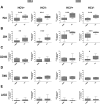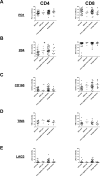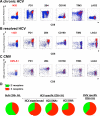Liver environment and HCV replication affect human T-cell phenotype and expression of inhibitory receptors
- PMID: 24148617
- PMCID: PMC3946973
- DOI: 10.1053/j.gastro.2013.10.022
Liver environment and HCV replication affect human T-cell phenotype and expression of inhibitory receptors
Abstract
Background & aims: There is an unclear relationship between inhibitory receptor expression on T cells and their ability to control viral infections. Studies of human immune cells have been mostly limited to T cells from blood, which is often not the site of infection. We investigated the relationship between T-cell location, expression of inhibitory receptors, maturation, and viral control using blood and liver T cells from patients with hepatitis C virus (HCV) and other viral infections.
Methods: We analyzed 36 liver samples from HCV antibody-positive patients (30 from patients with chronic HCV infection, 5 from patients with sustained virological responses to treatment, and 1 from a patient with spontaneous clearance) with 19 paired blood samples and 51 liver samples from HCV-negative patients with 17 paired blood samples. Intrahepatic and circulating lymphocytes were extracted; T-cell markers and inhibitory receptors were quantified for total and virus-specific T cells by flow cytometry.
Results: Levels of the markers PD-1 and 2B4 (but not CD160, TIM-3, or LAG-3) were increased on intrahepatic T cells from healthy and diseased liver tissues compared with T cells from blood. HCV-specific intrahepatic CD8(+) T cells from patients with chronic HCV infection were distinct in that they expressed TIM-3 along with PD-1 and 2B4. In comparison, HCV-specific CD8(+) T cells from patients with sustained virological responses and T cells that recognized cytomegalovirus lacked TIM-3 but expressed higher levels of LAG-3; these cells also had different memory phenotypes and proliferative capacity.
Conclusions: T cells from liver express different inhibitory receptors than T cells from blood, independent of liver disease. HCV-specific and cytomegalovirus-specific CD8(+) T cells can be differentiated based on their expression of inhibitory receptors; these correlate with their memory phenotype and levels of proliferation and viral control.
Keywords: CMV; Costimulation; HCV; IHL; Immune Regulation; Inflammation; PBMC; T-Cell Exhaustion; cytomegalovirus; hepatitis C virus; intrahepatic lymphocyte; peripheral blood mononuclear cell.
Copyright © 2014 AGA Institute. Published by Elsevier Inc. All rights reserved.
Figures






Similar articles
-
Expression of programmed cell death protein 1 and T-cell immunoglobulin- and mucin-domain-containing molecule-3 on peripheral blood CD4+CD8+ double positive T cells in patients with chronic hepatitis C virus infection and in subjects who spontaneously cleared the virus.J Viral Hepat. 2019 Aug;26(8):942-950. doi: 10.1111/jvh.13108. Epub 2019 Apr 29. J Viral Hepat. 2019. PMID: 30972915 Free PMC article.
-
Functional restoration of HCV-specific CD8 T cells by PD-1 blockade is defined by PD-1 expression and compartmentalization.Gastroenterology. 2008 Jun;134(7):1927-37, 1937.e1-2. doi: 10.1053/j.gastro.2008.02.033. Epub 2008 Feb 17. Gastroenterology. 2008. PMID: 18549878 Free PMC article.
-
Peripheral PD-1+ T Cells Co-expressing Inhibitory Receptors Predict SVR With Ultra Short Duration DAA Therapy in HCV Infection.Front Immunol. 2019 Jun 27;10:1470. doi: 10.3389/fimmu.2019.01470. eCollection 2019. Front Immunol. 2019. PMID: 31316516 Free PMC article. Clinical Trial.
-
T-cell exhaustion in chronic hepatitis B infection: current knowledge and clinical significance.Cell Death Dis. 2015 Mar 19;6(3):e1694. doi: 10.1038/cddis.2015.42. Cell Death Dis. 2015. PMID: 25789969 Free PMC article. Review.
-
Revisiting immune exhaustion during HIV infection.Curr HIV/AIDS Rep. 2011 Mar;8(1):4-11. doi: 10.1007/s11904-010-0066-0. Curr HIV/AIDS Rep. 2011. PMID: 21188556 Free PMC article. Review.
Cited by
-
Contradictory immune response in post liver transplantation hepatitis B and C.Int J Inflam. 2014;2014:814760. doi: 10.1155/2014/814760. Epub 2014 Aug 24. Int J Inflam. 2014. PMID: 25215259 Free PMC article. Review.
-
Hurdles to the Development of Effective HBV Immunotherapies and HCV Vaccines.Pathog Immun. 2017;2(1):102-125. doi: 10.20411/pai.v2i1.201. Epub 2017 Apr 9. Pathog Immun. 2017. PMID: 28664194 Free PMC article.
-
Immune responses and immunopathology in acute and chronic viral hepatitis.Nat Rev Immunol. 2016 Aug;16(8):509-23. doi: 10.1038/nri.2016.69. Epub 2016 Jul 4. Nat Rev Immunol. 2016. PMID: 27374637 Review.
-
HCV-specific CD4+ T cells of patients with acute and chronic HCV infection display high expression of TIGIT and other co-inhibitory molecules.Sci Rep. 2019 Jul 23;9(1):10624. doi: 10.1038/s41598-019-47024-8. Sci Rep. 2019. PMID: 31337800 Free PMC article.
-
The Inhibitory T Cell Receptors PD1 and 2B4 Are Differentially Regulated on CD4 and CD8 T Cells in a Mouse Model of Non-alcoholic Steatohepatitis.Front Pharmacol. 2019 Mar 13;10:244. doi: 10.3389/fphar.2019.00244. eCollection 2019. Front Pharmacol. 2019. PMID: 30949049 Free PMC article.
References
-
- Wherry EJ. T cell exhaustion. Nature immunology. 2011;12:492–9. - PubMed
-
- Day CL, Kaufmann DE, Kiepiela P, Brown JA, Moodley ES, Reddy S, Mackey EW, Miller JD, Leslie AJ, DePierres C, Mncube Z, Duraiswamy J, Zhu B, Eichbaum Q, Altfeld M, Wherry EJ, Coovadia HM, Goulder PJ, Klenerman P, Ahmed R, Freeman GJ, Walker BD. PD-1 expression on HIV-specific T cells is associated with T-cell exhaustion and disease progression. Nature. 2006;443:350–4. - PubMed
-
- Kasprowicz V, Schulze Zur Wiesch J, Kuntzen T, Nolan BE, Longworth S, Berical A, Blum J, McMahon C, Reyor LL, Elias N, Kwok WW, McGovern BG, Freeman G, Chung RT, Klenerman P, Lewis-Ximenez L, Walker BD, Allen TM, Kim AY, Lauer GM. High level of PD-1 expression on hepatitis C virus (HCV)-specific CD8+ and CD4+ T cells during acute HCV infection, irrespective of clinical outcome. J Virol. 2008;82:3154–60. - PMC - PubMed
Publication types
MeSH terms
Substances
Grants and funding
LinkOut - more resources
Full Text Sources
Other Literature Sources
Research Materials

